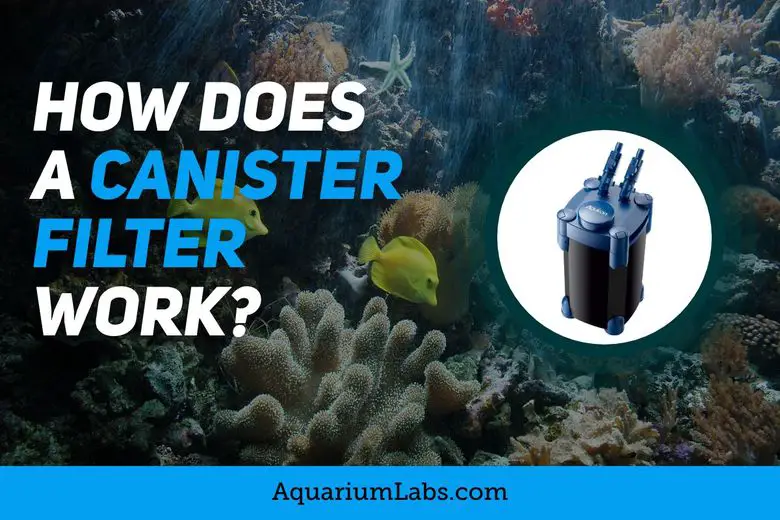Without a filter, aquarium water will retain dirt, chemicals, and other particles that are harmful to the fish in your tank.
If you’re in the market for canister filters, but you’re unsure how they work, our blog will explore everything you need to know to get started.
What is a Canister Filter?

A canister filter is a popular filtration device that is suitable for various types of aquariums.
The filter uses a filter media, pump, lift tube, gravity, and a canister-shaped design to remove unwanted particles from your aquarium’s water. A canister filter allows tank owners to take advantage of a variety of filtration types—you can remove anything from toxic chemicals to fish waste.
How Do Canister Filters Work in Aquariums?

A canister filter is named so because it is shaped like a canister and receives water from an intake pipe.
In most cases, the water will travel from the top of the canister to the bottom, where it is released back into the fish tank. A pump is used to ensure that constant water flows in the aquarium.
As the water travels through the filter chamber, it is filtered through various ‘media.’ Aquarium owners can layer this media manually, and you can use multiple media types if you want to benefit from different types of filtration.
Effective canister filters are efficient at cleaning large volumes of water via the pump. As a versatile filtration device with plenty of pump power and filter options, these products are a fan-favorite with many aquarium owners.
Canister Filter Maintenance
One of the primary benefits of using a canister filter is the low maintenance requirements.
Much of the water is forced through the filtration media, so you can quickly enhance the performance of the filter by replacing the media regularly. You will also need to replace any carbon that is located inside the filter as its waste saturation increases, or it will release toxins into the water.
The process of maintaining your filter canister will depend on the media. Each media type and brand will have different cleaning and maintenance instructions, for example. Make sure to follow the instructions provided to you by the manufacturer for the specific media that you purchase.
You’ll also need to maintain the inner components of the water pumps and tubes carefully. You can buy a tube cleaning kit that will automatically clean your tubing system and many modern canister filters are designed to be taken apart for easy cleaning. You shouldn’t have any problems accessing the inner components of your filter.
What You Should Know About Canister Filters
Now that you understand the basic mechanics of canister filters, it’s time to learn more about the various elements that dictate the quality of a filter.
Let’s explore some additional information that you should know before buying a new canister filter for your fish tank.
Types of Filter Media
One of the most important components of a canister filter is the filter media used to clean the water.
Canister filters allow you to customize your own filter media, so it’s important to choose the type that is best suited to your tank and its inhabitants. Some aquarium owners use loose media in canister filters, while others take advantage of filter media bags, for example.
Below, we’ll explore the three types filter media available to fish tank owners.
Biological
Biological filter media helps convert fish waste into less harmful substances.
For example, a biological media product may convert toxic ammonia into nitrite.
While biological media is highly effective at reducing the impact of fish waste, it will increase the toxic nitrite in your tank, so it’s also important to regularly change your fish tank water to avoid damaging your fish.
Chemical
Chemical filter media uses carbon to remove harmful chemicals from your tank water.
If you’re using carbon as a chemical media, it’s critical to change it regularly. If the carbon filters are saturated, it might pump harmful toxins back into your tank’s water supply.
Mechanical
Mechanical media is tasked with removing particles from the aquarium water. When it’s particularly fine, it will catch smaller particles, but fine mechanical media will also clog more easily and will require constant replacement.
Flow Rates
The flow rate of your canister filter dictates the amount of aquarium water that it can clean.
Water pumps are largely responsible for the flow rate of the canister filter, so the bigger your aquarium is, the stronger the pump will need.
As your water pump pushes current back into your aquarium, it will likely be released using a spill or spray bar. The benefit of a spray bar is that it can increase the circulation in your aquarium significantly.
Assess the flow rate of a canister before you make a purchase. It’s critical that it has a gallon per hour (GPH) rate powerful enough to clean your tank’s entire contents.
What is the Best Canister Filter?
If you’re in the market for a new external filter for your aquarium, it’s critical to choose the best product.
Canister filters are extremely effective at cleaning aquariums, so the quality of your filtration system will primarily depend on the model that you purchase. If you’re searching for the best canister filters on the market, it’s vital to research the leading products before you make a purchase.
Filter brand reputation, media baskets, power source, capacity, noise level, and other core features are all essential when considering buying a power filter.
If you want to learn more about canister filters or other aquarium products, be sure to explore the other resources on our website.
Related:
- How Often Should You Clean Your Canister Filter
- 9 Best Filters for Turtle Tanks [Top Picks and Reviews]
- Is It Bad If You Over Filter Your Tank?


